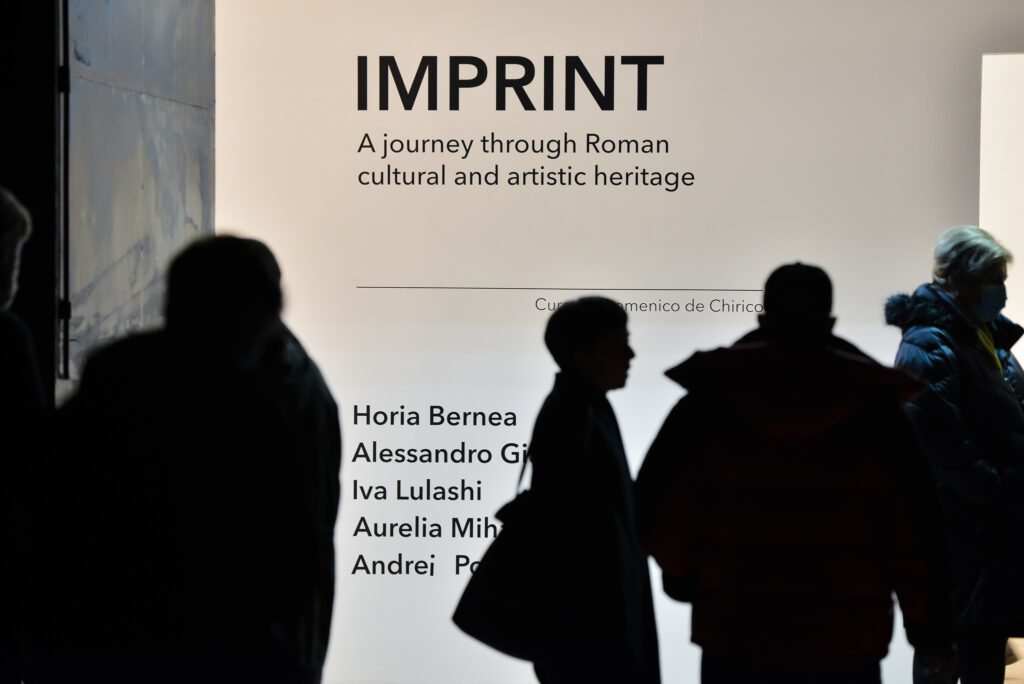IMPRINT. A Journey through Roman cultural and artistic heritage
17 February – 31 March 2022
Artists: Horia Bernea, Alessandro Giannì, Iva Lulashi, Aurelia Mihai, Andrei Pokrovskii, Lucian Popăilă, Nicola Samorì, Paul Timofei, Nicola Verlato și Bogdan Vlăduță
Curated by: Domenico de Chirico
Location: Sector 1 Gallery
Language, verbal and gestural, is philologically and diachronically defined as the closest communication system that a person has in his service to actively participate in the life of the community they belong to, absorbing its cultural baggage, allowing people to communicate with each other. It is through it that man can express his cultural belonging, his political, cultural, religious ideas, his most hidden and vehement feelings, inside of a microsystem whose evolutionary paradigm is continuous, among archetypes and neologisms that together bring to light the power of language and words. In fact, geographically speaking, the variety of idiomatic expressions has been a fundamental element in the creation of ethnic groups and so-called organized spaces, generally defined as cultural regions. The connection that unites language, society and territory is a special, logically set means to better understand, starting from its own roots, the reality among the events that just took place, current events and premonitions about future developments. The group exhibition “IMPRINT. A journey through Roman cultural and artistic heritage” is based exactly on the above-mentioned principles.
The main purpose of the exhibition is to focus on a given space, geographically understood, able to influence certain generations of artists and thinkers, thus giving birth to or shaping certain artistic languages and stimulating creative efforts of various kinds and different entities. Therefore, being the general socio-cultural space marked by an eternal and living culture, both historical and cultural, cities like Rome, and countries like Italy, represented and still symbolize indisputable and heterogeneous magnificence, unanimously recognized. In view of these things, “IMPRINT. A journey through Roman cultural and artistic heritage” focuses precisely on the city of Rome, taken directly as an apodictic and undeniable incubator of knowledge and beauty, which lets itself be conquered by the thrill of a journey exciting in its time, to be able to celebrate the artistic and cultural heritage that distinguishes it. The exhibition is composed as follows: Bogdan Vlăduță who lived and painted in Rome between 2002-2007 is already known for his paintings about Rome. He has manisfested through numerous examples of artistic incarnations of the Roman type, from plein-airism investigations in the note of the classicizing Le Grand Tour, to bookish conclusions and continuous research on the Roman artistic heritage. Vlăduță confesses: “At a metaphysical and iconographic level, Rome possesses the expression of evidence, with an unrepeatable potential at the level of European urban history, but also a chance waiting to be fructified through painting. The meeting with the place can only become profitable under the sign of Tradition: the real measure, the adumbration of fiction through the relaunch of figurative models and the rhetoric of advancement/innovation through return/relapse and mystical cadence.”; Lucian Popăilă’s paintings are visually arresting attempts to depict the realm of the commonplace, while granting it ontological dignity and a sort of iconic status. From Giorgio de Chirico to Giorgio Morandi, Lucian Popăilă’s plants recall a world suspended in time, where craftmanship and the contemplation of what the act of painting should be is defined by the simplicity of the brushstroke gesture mixed in the speed of fresco painting, recalling a mysterious beauty born in ancient worlds; Paul Timofei’s works focus on landscapes and depictions of ruins as a matter of geographical connection. His view on the urban mosaic tales is strictly connected with the historical layering of a city like Rome, where the abundance of ruins gives birth to a captivating visual narrative, not necessarily rhetorical. Moreover, in his paintings, the disintegration of the landscape is a central motif to question notions as beauty and fragility; the works of visual artist and filmmaker Aurelia Mihai question a variety of dimensions of modern life, both in Romania and universally. These dimensions range from the position of the viewer and their spatial relationship with art, to the environment that surrounds them, up to the political and cultural clash: ancient against new, foreign against native. In this context, the boundaries between fiction and non-fiction are frequently blurred where cultural traditions are re-written using a contemporary register; Horia Bernea is a cornerstone for Romanian contemporary art, being emblematic for the transition from the avant-garde stage practiced in the beginning of the 1970s to the purest form of traditional art. Going backwards from a conceptual iconography, post-cognitive, towards a redefining of the major themes of figurative painting in a sacral note. The Roman period of his oeuvre coincides with the last part of his life, as a conclusion to his entire artistic career, as a revelation that millennial art of Rome is a paradigm that validates posthumously his prolific artistic path. In the period of his Roman trips, his works tend to emphasize an old and obsessive problem for the artist, the consistency and materiality of painting, but not in formalist terms, but as a means to certify the very substance of timeless art. He questioned the city of Rome, rich in visual details, in catacomb painting or imperial domus frescos, in stunning mosaics and polychrome marbles that decorate old churches and sublimate the sense of daily sacrality; in his artistic work, the Roman Alessandro Giannì gathers aesthetic fragments from the web with the intention of giving them a new existence, an innovative poetics. In his artworks the analogical practice of painting merges with the use of new media, with the Internet and digital culture, investigating the connections between the digital universe, parallel universes, and the dreamlike and introspective world of human beings; Nicola Verlato is known for his socially engaged paintings and sculptures which use the strength and the ability of figurative art to emotionally involve the viewer. In order to further empower his images, he uses an articulated process that combines classical techniques as well as modern technologies such as 3D Modeling programs. In his works he composes mythological scenes with material drawn from popular culture. Verlato’s research is based on the material concreteness of a virtuous figurative painting that, without referential banality, casts an eye on the past and reinterprets Renaissance art by projecting it on a futurist background; In his intense creative process, the famous painter and sculptor Nicola Samorì highlights the attempt to endanger forms coming from the history of Western culture: the opening of the represented body and the pictorial surface are shown without a solution of continuity, giving the feeling that the birth of a new work always involves the sacrifice of an ancient one because as he himself affirms: “art is a breach in time, something that numbs our race.” At first meticulously copying the works of the great masters, especially of the XVI and XVII centuries, dominated by the contrast between light and shadow, Samorì transforms them and reinterprets them in the troubled spirit of the century to which he belongs. With violent interventions, he literally pierces, scratches and skins the painting surface through his sudden and meticulous action, thus giving life to a new work with roots well embedded in the tradition of art history, but which then comes to express the deepest anxiety through contemporary language; the desacralizing artistic research of Iva Lulashi generally starts from photograms and theatrical proscenium that who sharply tell about the visual language of Albanian history, combined with erotic scenes and healthy outdoor activities. Gradually giving up the academic visual repertoire and heavy historical disguises, Lulashi crosses the threshold of the ordinary until she dismisses the stage curtain to freely talk about the scandal of truth. The works of Andrei Pokrovskii are entirely devoted to the problem of relations with various places and to the attachment to spaces real, mythical or virtual, through the experience gained in their context which moves freely from the sexual hemisphere to the behavioral and from meditative to emotional. In his works there is always a “stage” with the lively protagonists who come and go from this place. On this “stage” the scenery controls the characters through the created atmosphere and the specific conditions of permanence. In this way, through the body manipulations both actors and viewers gain the exceptional experience of staying in a particular location.
Looking for more?
Address
Băiculești 29 Street, District 1, 013193, Bucharest, Romania
Opening Hours
Tuesday – Saturday, 2 – 7 PM
Sunday – Monday, by appointment only
Newsletter
Sign up to receive the latest news on the gallery’s artists
Sector 1 Gallery © 2023. All Rights Reserved.
Privacy Policy

